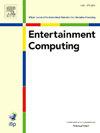Imputation of missing pixel art character poses with differentiable palette quantization
IF 2.4
3区 计算机科学
Q2 COMPUTER SCIENCE, CYBERNETICS
引用次数: 0
Abstract
Designing pixel art character sprites with numerous animation frames is a labor-intensive process that often involves repetitive work. To streamline this task, we propose a method that automates sprite generation, allowing artists to focus on the creative aspects. Our work addresses the challenge of synthesizing a character sprite in a target pose using reference images from other viewing angles. We formulate this as a missing data imputation problem and introduce a generative adversarial network that reconstructs the desired pose from those already available among the back, left, front, and right directions. Unlike baseline models, our proposed generator utilizes all available poses of a character to enhance the quality of the generated image. Additionally, it does not introduce small variations of the same colors and instead produces images that strictly follow a predefined color palette. Crucially, our model ensures adherence to the palette by incorporating a novel operation of differentiable quantization of pixel values, making it suitable for end-to-end training. Compared to baseline models proposed for generating a new pose from a single one, our approach produces images with better FID (34.09% lower) and distance to the ground truth (22.66% lower). It also shows superior quality through visual inspection. Additionally, as the generator selects colors from a desired palette, similar to how human artists create pixel art, the generated images are more readily useful, eliminating the need for a post-processing step to restrict the color.
基于可微调色板量化的缺失像素艺术特征位姿的插值
设计具有大量动画帧的像素艺术角色精灵是一个劳动密集型过程,通常涉及重复性工作。为了简化这项任务,我们提出了一种自动生成精灵的方法,允许美工专注于创意方面。我们的工作解决了使用其他视角的参考图像在目标姿势中合成角色精灵的挑战。我们将其表述为缺失数据输入问题,并引入生成式对抗网络,该网络从后、左、前、右方向中已有的数据重建所需姿态。与基线模型不同,我们提出的生成器利用角色的所有可用姿势来增强生成图像的质量。此外,它不会引入相同颜色的小变化,而是严格遵循预定义的调色板生成图像。至关重要的是,我们的模型通过结合像素值的可微分量化的新操作确保了对调色板的依从性,使其适合端到端训练。与从单个姿态生成新姿态的基线模型相比,我们的方法产生的图像具有更好的FID(降低34.09%)和L1到地面真值的距离(降低22.66%)。通过目测也能看出质量上乘。此外,由于生成器从所需的调色板中选择颜色,类似于人类艺术家创建像素艺术的方式,生成的图像更容易使用,消除了限制颜色的后处理步骤的需要。
本文章由计算机程序翻译,如有差异,请以英文原文为准。
求助全文
约1分钟内获得全文
求助全文
来源期刊

Entertainment Computing
Computer Science-Human-Computer Interaction
CiteScore
5.90
自引率
7.10%
发文量
66
期刊介绍:
Entertainment Computing publishes original, peer-reviewed research articles and serves as a forum for stimulating and disseminating innovative research ideas, emerging technologies, empirical investigations, state-of-the-art methods and tools in all aspects of digital entertainment, new media, entertainment computing, gaming, robotics, toys and applications among researchers, engineers, social scientists, artists and practitioners. Theoretical, technical, empirical, survey articles and case studies are all appropriate to the journal.
 求助内容:
求助内容: 应助结果提醒方式:
应助结果提醒方式:


